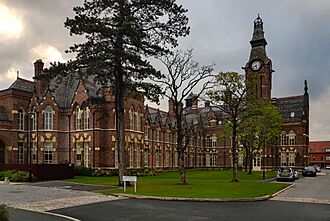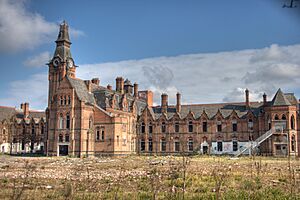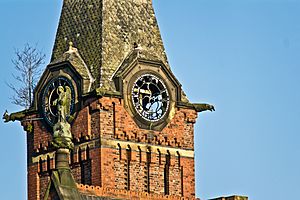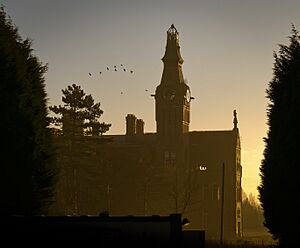Barnes Hospital, Cheadle facts for kids
Quick facts for kids Barnes Hospital |
|
|---|---|

The restored and redeveloped hospital in 2020
|
|
| Former names | Barnes Convalescent Home |
| General information | |
| Status | Converted into apartments |
| Type | Former hospital |
| Architectural style | French Gothic Revival |
| Location | Cheadle, Greater Manchester, England |
| Coordinates | 53°23′50″N 2°13′24.7″W / 53.39722°N 2.223528°W |
| Construction started | 1871 |
| Completed | 1875 |
| Renovated | 1893, 1945 |
| Design and construction | |
| Architect | Lawrence Booth |
| Designations | |
|
Listed Building – Grade II
|
|
| Official name: Barnes Hospital | |
| Designated: | 12 November 1999 |
| Reference #: | 1379609 |
Barnes Hospital, located in Cheadle, England, used to be a hospital. It sits right on the edge of Manchester and Stockport, close to major roads like the A34, M60, and M56 motorways. The main building is a special 'Grade II listed' building, meaning it's protected because of its history and architecture. It's also on 'green belt' land, which is protected from too much building.
Finished in 1875, this building is a great example of Victorian Gothic Revival architecture style. It's a well-known landmark, sitting on a small hill overlooking the roads around it. The hospital closed its doors in 1999. Even though it was quickly protected as a listed building to stop it from being knocked down, it became empty and run-down for a while.
Today, the old hospital building has been turned into apartments. It's now the main part of a new neighborhood called Barnes Village.
Contents
The Hospital's Story
Why a Convalescent Hospital?
After Florence Nightingale improved nursing in the 1860s, there was a greater need for 'convalescent care'. This is special care for people recovering from illness or injury. A kind person named Joseph Adshead pushed for a recovery hospital in Manchester. After he passed away in 1861, the Manchester Royal Infirmary rented Cheadle Hall to use as a recovery hospital.
They chose this rural spot to help patients get better away from the smoky air of industrial Manchester. Even though it was once quiet, the area is now surrounded by busy main roads.
Who Helped Build It?
In 1869, a generous local businessman named Robert Barnes donated £10,000 to start a new recovery hospital in Cheadle. He had made his money in the cotton trade in Manchester and had even been the mayor of Manchester from 1851 to 1853. Mr. Barnes later gave even more money, bringing his total gift to £26,000. Another donor, Humphrey Nicholls, also gave £10,000.
Construction of the Barnes Convalescent Home began in 1871 and finished in 1875. It was built with bricks made from local clay and had 132 beds for patients.
Ancient Discoveries During Construction
During the building of the hospital in 1874, workers found broken pieces of three old stone crosses. We only know where one of these pieces is today. It's the top part of a Celtic cross with a round center, dating back to the late 900s or early 1000s. You can see it now in St Mary's Church, Cheadle. The other two pieces are thought to be from even older crosses.
How the Hospital Changed Over Time
The hospital often lost money each year, and the Manchester Royal Infirmary had to help pay for it. However, in 1925, they agreed this allowed more patients to be treated at the main hospital. That same year, electricity and running water were installed.
Later, when a bone and joint department was set up at the infirmary, many patients needing long-term care came to Barnes. The hospital added lifts, a surgery room, an X-ray department, and areas for physical and occupational therapy.
Barnes Hospital During Wartime
During World War II, Barnes Hospital became a place for wounded soldiers to recover. It continued to care for injured soldiers and trauma patients throughout the war. On the same site, there was also a fever hospital. This is where patients with illnesses like tuberculosis were treated in separate wards to prevent the spread of disease.
In its later years, the main purpose of the hospital was to care for older patients and those who had suffered strokes. It's estimated that the hospital treated tens of thousands of patients over its 115 years as a recovery home.
Closure and New Beginnings
Barnes Hospital closed in September 1999 because the healthcare trust needed to save money. In the same year, the hospital building was given its special Grade II listed status. After closing, the hospital temporarily housed a large group of refugees from Kosovo. In February 2007, about 100 Romani families briefly stayed on the site.
The hospital was sold in 2001. For several years, the building was left empty and became very run-down. It was later sold to a new development group. This group planned to build 128 new homes around the hospital building.
Building Style and Design
The Barnes Convalescent Hospital was built for the Manchester Royal Infirmary between 1871 and 1875. The architect was Lawrence Booth. It's known for its unique look and as one of the first hospitals built specifically for recovery.
The building was designed in the French Gothic Revival style. It has a cross shape when viewed from above. It was built using red and blue bricks with stone and terracotta decorations. The roofs are covered with Welsh slate. The building has lots of fancy brickwork, pointed and mullioned windows, and decorative roof tiles.
On the west side, you'll find the building's most famous feature: a tall clock tower. It has clock faces on each side and a high, two-part roof topped with a decorative iron crown. Some changes were made to the building in 1893 and again between 1939 and 1945.
A famous architectural guide described the building simply as "large, Gothic and grim." When it was empty, people called it a "great gaunt pile of a building, abandoned and all dark at night, except for the lonely light in its tower-top clock."
Filming Location
Barnes Hospital has been used as a location for movies and TV shows.
Movies and TV Shows
The Spanish director Jorge Grau used Barnes Hospital for his 1974 horror film, Let Sleeping Corpses Lie. Critics praised Grau's choice of locations for showing England as a "bleak place." He used the old, decaying look of Barnes Hospital to create the fictional Manchester Morgue in the film.
In September 2005, the Barnes Hospital building was featured on the TV show Most Haunted Live, which explores paranormal activity.
New Life for Barnes Hospital
A project to redevelop the site began in 2015. This included turning the old hospital building into apartments. The new housing development is now known as Barnes Village.
See also
- Listed buildings in Cheadle and Gatley
- Healthcare in Greater Manchester
- List of hospitals in England




